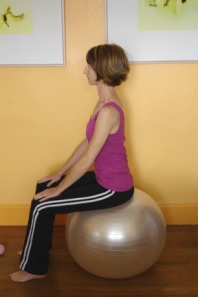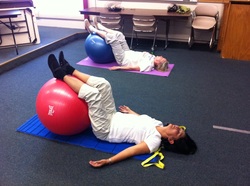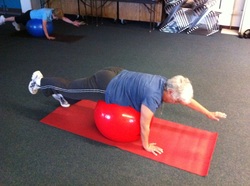| FitnessMuse |
|
How to Purchase a Stability Ball

Selecting the Correct Ball Size
Swiss exercise balls come in a variety of sizes ranging from 30 to 75 cm. Selecting the ball size that is right for you depends primarily on your height. When sitting on a fully inflated ball, your hips and knees should be bent at approximately a 90 degree angle, with your thighs parallel to the floor (see picture at left).
I consulted multiple sources, including the book, Abs on the Ball by Colleen Craig (an excellent resource for instructors and students alike), and various companies that sell the balls. All of them offer a slightly different set of guidelines,In so I consolidated the information, compared it with my own experience and how my class will be using the ball, and came up with the following parameters:
Size Guide for Stability Balls
45 cm: If you are under 5'
55 cm: 5' to 5'7" (Most people will find this size suitable. Unless you are taller or shorter than average, the 55 cm ball is a good size to go with.)
65 cm: 5'7" to 6'
75 cm: taller than 6'
Where to Buy a Stability Ball
In person:
Most sporting goods stores (e.g., Dick's Sporting Goods, Big 5) carry stability balls. Target, Marshalls, TJ Maxx, and even Bed Bath and Beyond sometimes carry stability balls. I recommend calling ahead to make sure they have the size you need.
Online:
Amazon.com (Best prices. Search "Stability Ball" or "Pilates Ball" or "Swiss Ball")
OPTP.com (OPTP carries my preferred brand, Gymnic. More expensive, but generally high quality.)
Performbetter.com
Power-systems.com
Look for balls that are labeled burst-resistant (most balls seem to carry that label, so it shouldn't be too hard to find one). Make sure you check the size listed on the box.
Inflating and Storing Your Stability Ball
The ball should come with inflation instructions and a pump. Follow those instructions. Balls are measured by their diameter (height from the floor) not by air pressure. Some balls come with a measuring tape to ensure correct inflation. Otherwise, use a yardstick. Using the manual pump, it might have to take a few "inflation sessions" to fully inflate the ball, meaning you may only be able to inflate it to a certain point and then you'll have to wait a day or two as the material stretches out a bit, then inflate some more.
If you are brand new to using the ball and think you might feel a little unstable on it, leave it slightly soggy. Store your ball in a cool, dark location protected from the sun and heat.
Swiss exercise balls come in a variety of sizes ranging from 30 to 75 cm. Selecting the ball size that is right for you depends primarily on your height. When sitting on a fully inflated ball, your hips and knees should be bent at approximately a 90 degree angle, with your thighs parallel to the floor (see picture at left).
I consulted multiple sources, including the book, Abs on the Ball by Colleen Craig (an excellent resource for instructors and students alike), and various companies that sell the balls. All of them offer a slightly different set of guidelines,In so I consolidated the information, compared it with my own experience and how my class will be using the ball, and came up with the following parameters:
Size Guide for Stability Balls
45 cm: If you are under 5'
55 cm: 5' to 5'7" (Most people will find this size suitable. Unless you are taller or shorter than average, the 55 cm ball is a good size to go with.)
65 cm: 5'7" to 6'
75 cm: taller than 6'
Where to Buy a Stability Ball
In person:
Most sporting goods stores (e.g., Dick's Sporting Goods, Big 5) carry stability balls. Target, Marshalls, TJ Maxx, and even Bed Bath and Beyond sometimes carry stability balls. I recommend calling ahead to make sure they have the size you need.
Online:
Amazon.com (Best prices. Search "Stability Ball" or "Pilates Ball" or "Swiss Ball")
OPTP.com (OPTP carries my preferred brand, Gymnic. More expensive, but generally high quality.)
Performbetter.com
Power-systems.com
Look for balls that are labeled burst-resistant (most balls seem to carry that label, so it shouldn't be too hard to find one). Make sure you check the size listed on the box.
Inflating and Storing Your Stability Ball
The ball should come with inflation instructions and a pump. Follow those instructions. Balls are measured by their diameter (height from the floor) not by air pressure. Some balls come with a measuring tape to ensure correct inflation. Otherwise, use a yardstick. Using the manual pump, it might have to take a few "inflation sessions" to fully inflate the ball, meaning you may only be able to inflate it to a certain point and then you'll have to wait a day or two as the material stretches out a bit, then inflate some more.
If you are brand new to using the ball and think you might feel a little unstable on it, leave it slightly soggy. Store your ball in a cool, dark location protected from the sun and heat.
Proudly powered by Weebly

